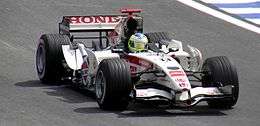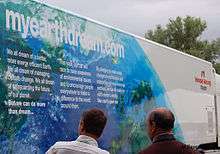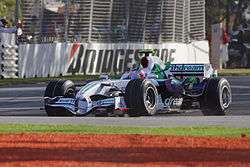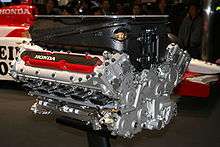Honda in Formula One
|
| |
| Full name |
Honda Racing F1 Team (2006–2008) Honda R & D Company (1964–1968) |
|---|---|
| Base |
Tokyo, Japan (1964) Amsterdam, Netherlands (1965–1966) Slough, UK (1967–1968) Brackley, UK and Tochigi, Japan (2006–2008)[1] |
| Noted staff |
Ross Brawn Nick Fry |
| Noted drivers |
|
| Previous name | British American Racing |
| Next name | Brawn GP Formula One Team |
| Formula One World Championship career | |
| First entry | 1964 German Grand Prix |
| Races entered | 88 |
| Engines | Honda |
| Constructors' Championships | 0 |
| Drivers' Championships | 0 |
| Race victories | 3 |
| Podiums | 9 |
| Points | 154 |
| Pole positions | 2 |
| Fastest laps | 2 |
| Final entry | 2008 Brazilian Grand Prix |
Honda has participated in Formula One, as an entrant, constructor and engine supplier, for various periods since 1964. Honda's involvement in Formula One began with the 1964 season; their withdrawal in 1968 was precipitated by the death of Honda driver Jo Schlesser during the 1968 French Grand Prix.[2] They returned in 1983 as an engine supplier, a role that ended in 1992. They returned again in 2000, providing engines for British American Racing (BAR). By the end of 2005 they had bought out the BAR team, based at Brackley, United Kingdom, and renamed their new subsidiary Honda Racing.
It was announced on 5 December 2008 that Honda would be exiting Formula One with immediate effect due to the global financial crisis and were looking to sell their team.[3] On 27 February 2009 it was announced that team principal Ross Brawn had led a management buyout of the Brackley team.[4] The team raced successfully as Brawn GP in 2009, and was subsequently sold to Daimler AG and renamed Mercedes GP for the 2010 season.
On 17 May 2013, Honda announced their intention to return to the sport in the 2015 season under a works agreement with McLaren to supply V6 engines and kinetic energy recovery system (KERS) units.[5]
History
Honda R & D Company (1964–1968)
Honda entered Formula One Grand Prix racing in 1964, just four years after producing their first road car. They began development of the RA271 in 1962 and startled the European-dominated Formula One garages with their all-Japanese factory team (except for American drivers Ronnie Bucknum and Richie Ginther). More startling was the fact that Honda built their own engine and chassis, something only Ferrari and BRM – of the other teams still running in 1962 – had previously done.

In only their second year of competition, Honda reached the coveted top step of the podium with Ginther's win in the RA272 at the 1965 Mexican Grand Prix. For the new 3.0L rules from 1966, Honda introduced the Honda RA273. Although the RA273's engine was a well-designed, ~360 bhp V12, the car was let down by a relatively heavy and unwieldy in-house chassis. Honda returned to the winner's circle in 1967 with the new Honda RA300, driven by John Surtees. This won the 1967 Italian Grand Prix in only its first Formula One race. The RA300 chassis was partly designed by Lola in the UK, and this resulted in the car being nicknamed the Hondola by the motoring press. This was the last competitive car that Honda produced for Formula One in the 1960s.
The following year's Honda RA301 only reached the podium twice. The team's new Honda RA302 appeared in only a single race at Rouen-Les-Essarts, lasting only a few laps before its fiery crash resulted in the death of driver Jo Schlesser. The death prompted Honda to withdraw from Formula One at the end of the 1968 Formula One season.[2]
Aborted 1999 Formula One project
From 1993 to 1998, Honda's only presence in Formula One was as an engine supplier through its closely related but independent partner, Mugen Motorsports, who supplied engines to Footwork, Lotus, Ligier, Prost and Jordan. Mugen-powered cars had won 4 Grands Prix by the end of the 1999 season. In 1998, Honda was seriously considering entry in Formula One as a constructor, going as far as producing an engine and hiring Harvey Postlethwaite as technical director and designer. In addition, Honda pulled engineer Kyle Petryshen from HRC to help with the design, implementation and management of the new engine in the new chassis.[6] A test car, RA099, designed by Postlethwaite and built by Dallara, was made and tested during 1999, driven by Jos Verstappen. The team impressed at test sessions, beating some more experienced and better financed teams, even if they were mostly in the midfield. At a test of this car, Postlethwaite suffered a fatal heart attack, the project was later shelved and Honda decided to merely recommit as a full works engine supplier to BAR, starting in 2000.
Honda Racing F1 Team (2006–2008)
In September 2005 Honda purchased the remaining 55% share of BAR to become the sole owner. BAT continued as title sponsor with the Lucky Strike brand in 2006, but withdrew from Formula 1 for 2007. It was decided that the team would race under the name Honda Racing F1 Team from 2006.
2006 season
Despite showing promise pre-season (with the RA106 being considered one of the most powerful of the new V8 engines), Honda demonstrated fairly mediocre performance at the start of the 2006 season despite a pole position at Australia. Prior to their win at Hungary, they had only accumulated a single podium finish, a third place from Jenson Button at Malaysia. The main reason for lack of form (the team was expecting to challenge for the championship) was down to reliability, with the team dropping out of contention for race victories many times. Pit-stop problems also hampered the team early on, in one case effectively ruining Jenson Button's chances for a good result and possible podium at Imola. Rubens Barrichello did not have a good season for the team, down to the fact that he had to get used to the new brakes and traction control, after moving from a very successful six-year stint at Ferrari. Nevertheless, Rubens had out-qualified his team-mate in two of the final four races.
Honda had a particularly poor showing at the British Grand Prix in 2006. In particular, Jenson Button was eliminated after the first portion of qualifying after the team failed to get him out for a second run. This resulted in his qualifying 19th. He then retired with an oil leak. In light of this poor form, it was announced that Geoff Willis would be adopting a factory-based role to concentrate on aerodynamics. Following the appointment of Senior Technical Director Shuhei Nakamoto over Willis' head and Mariano Alperin-Bruvera as Chief Aerodynamicist Willis' position appeared difficult, and reports indicated that he left the team.

At the Hungaroring, fortunes changed. Barrichello and Button qualified third and fourth, though Button had to drop ten places, following an engine change. In an incident-packed race, Button came from fourteenth on the grid to win his first race, with Barrichello finishing fourth. After this win, the team's performance went up noticeably, displaying consistency (if not overall performance) arguably better than championship leaders Ferrari and Renault. Button scored as many points as championship runner up Michael Schumacher in the last third of the season. Both drivers earned points finishes in almost all the remaining races (with the exception of Barrichello's 12th-place finish in Japan), with the season ending high note with Button's 3rd-place finish in Brazil – less than a second behind 2nd place Fernando Alonso – after having to start from 14th on the grid.
On 15 November 2006, it was announced that long time BAR Honda and Honda test driver, Anthony Davidson would be heading to Super Aguri F1 to race alongside Takuma Sato. He was replaced by ex-Red Bull Racing driver Christian Klien for the 2007 season.
2007 season


With tobacco sponsorship in Formula One in full decline, 2007 also saw the end of British American Tobacco's sponsorship of Honda, allowing the team to choose a livery that better suited their corporate image. Unveiled on 26 February 2007, the RA107 car featured the bare minimum of corporate advertising (advertising required by the FIA), instead focusing on Honda's environmental desires, with a livery depicting the planet Earth against the black background of space. On the rear wing was the web address of environmental awareness website myearthdream.com. This site was launched 27 February 2007, immediately after the official launch of the 2007 car. Reactions to the new Honda livery were mixed, and Greenpeace accused the team of hypocrisy, given the pollution from F1.[7]
The team's form in pre-season testing was patchy, and Jenson Button urged the squad to improve. The RA-107's sheer lack of pace was evident at the season-opening Australian Grand Prix in Melbourne on 18 March, with Button and Barrichello qualifying 14th and 17th respectively (well behind the "satellite" Super Aguri team, whose car is effectively an update of the previous year's Honda, the RA-106). Barrichello finished the race in 11th place, with Button in 15th after receiving a drive-through penalty for speeding in the pit lane. The team also failed to score points in the four subsequent races, their best finish being 10th in Spain and Monaco, scored both times by Rubens Barrichello. Honda finally scored a point in the French Grand Prix, courtesy of Button's eighth-place finish.
From July 2007, recognising the aerodynamic problems within the car, Honda began to recruit a new team from across the Formula 1 paddock. Chief aerodynamicist Loic Bigois and assistant Francois Martinet were signed from WilliamsF1; Jörg Zander and John Owen from BMW Sauber either later in 2007 or early in 2008.[8]
2008 season

On 19 July 2007, it was announced that Barrichello and Button would continue the factory effort as teammates into 2008.[9] On 12 November 2007, autosport.com confirmed that former Ferrari technical director Ross Brawn was to join Honda as team principal. Nick Fry remained with the team as Chief Executive.[10] On 10 January 2008, it was announced that Alexander Wurz had signed as test driver for the 2008 Formula One Season.[11] On 29 January 2008, Honda launched their 2008 race car. The "Earth Car" had a slightly different livery from its 2007 counterpart, with only part of the car containing the earth picture, and the rest with Honda's classic white paint. Button, Barrichello and Wurz were present at the launch.
Honda had another disappointing year, and by mid-season they had switched development to the 2009 season, where new regulations come into play. Despite this, Barrichello managed a podium in the wet British Grand Prix with an inspired choice to full wet weather tyres at the right moment.
Sale and formation of Brawn GP
Honda exited the sport at the end of the 2008 season, unwilling to continue the Brackley-based team's $300 million budget and staff of 700 during the global economic crisis.[2] The team continued to work on the Honda RA109 for the 2009 season while Honda attempted to sell the racing team. A number of potential owners were linked to the team, including Prodrive boss David Richards, Mexican businessman Carlos Slim, and the Virgin Group.[12][13][14]
The team was eventually saved by a management buy-out led by team principal Ross Brawn and chief executive Nick Fry,[4] and would enter the 2009 season as Brawn GP.[15] The team retained Jenson Button and Rubens Barrichello as drivers, and would use engines supplied by Mercedes.[16] Honda would continue to provide financial support during the teams first year, and the Virgin Group who were linked to purchasing the team, would sponsor the cars throughout the season.
Honda as an engine supplier
Spirit, Williams, Lotus, McLaren and Tyrrell (1983–1992)
Honda returned to Formula One in 1983 as an engine supplier for Spirit and stayed in the sport for a decade, at various times teaming with Williams (1984–87), Lotus (1987–88), McLaren (1988–92) and finally Tyrrell (1991). Though they often supplied their engines to more than one team per season, Honda didn't always supply the same specification engines to different teams in the same season. For example, in 1987 as Williams had an existing contract, they were supplied with the latest 1.5 litre RA167-E V6 engine, while Lotus were supplied with the 1986 RA166-E engine which had to be adapted to a lower fuel limit and turbo boost restriction, thus limiting its effectiveness. Also, in 1991, while McLaren had the latest RA121-E V12, Tyrrell were only given the RA100-E V10's that McLaren had used in 1990. McLaren had direct Honda factory support, with engines coming straight from the Japanese company's racing division in Japan; while Tyrrell had to make do with the previous RA-100 model that were tuned by private Honda tuner Mugen; they had little to no direct factory support.
At their peak (1986–91) Honda engines were considered the ticket to Grand Prix glory due to their power, reliability, sophistication and winning track record. Honda's commitment to F1 was such that Briton Nigel Mansell, who drove Honda-powered Williams cars from 1985 to 1987 recalled in a 2011 interview that Honda were making and developing 4 to 6 totally different engines in a single season. Honda supplied its engines to six consecutive constructor champions (two with Williams 1986–87 and four with McLaren 1988–91), as well as five consecutive driver championships (one by Nelson Piquet in 1987, three by Ayrton Senna in 1988, 1990 and 1991, and one by Alain Prost in 1989), before dropping out of the sport again.
Honda-powered cars had won 71 Grands Prix, by the end of the 1992 season.
BAR and Jordan (2000–2005)

Honda returned yet again in 2000, providing engines for BAR. They also supplied engines to Jordan Grand Prix for 2001 and 2002. This would lead to a battle for the right to use the Honda engines in the long term. In 2003, despite their better showing in the previous two seasons, Honda dropped Jordan Grand Prix. In mid-November 2004 Honda purchased 45% of the BAR team from British American Tobacco (BAT, the founder and owner of BAR) following BAR's best season, when they were able to achieve second place in the 2004 Formula One season, a year dominated by Michael Schumacher and Ferrari.
McLaren (2015–)
Honda returned to Formula One as an engine supplier in 2015, reviving their relationship with 1980s partner McLaren.[5] However, the engine has so far proved to be significantly underpowered and inefficient. In addition it has been so unreliable that the team were hit with a record 105-grid position penalty at the Belgian Grand Prix.[17] In Belgium engine chief Yasuhisa Arai, claimed that the engine was 25 horsepower (19 kW) more powerful than the Renault plant, and on a par with the Ferarri. However, just one race later at Monza, Arai admitted that the Honda engine was in fact 180 horsepower (130 kW) down on the Renault. However, Arai refused to apologise for the poor performance of the engine.[18] Arai was replaced as head of Honda's Formula One programme by Yusuke Hasegawa on 1 March 2016. During the 2016 season Hasegawa admitted that the poor performance of the Honda engine meant that "only luck will put them on this year's podium" and "in our current situation, there are not many teams who want our engine".[19] In 2016 Hasegawa was asked when the Honda engine would be competitive with the second tier engines of Ferrari and Renault, to which Hasegawa admitted "maybe next year", two years later than when Arai claimed the Honda engine was more powerful.[20]
Formula One customer engine results
| Constructor | Season(s) | Total wins | First win | Last win |
|---|---|---|---|---|
| | 1983 | 0 | – | – |
| | 1983–1987 | 23 | 1984 Dallas Grand Prix | 1987 Mexican Grand Prix |
| | 1987–1988 | 2 | 1987 Monaco Grand Prix | 1987 Detroit Grand Prix |
| | 1988–1992, 2015–2016 | 44 | 1988 Brazilian Grand Prix | 1992 Australian Grand Prix |
| | 1991 | 0 | – | – |
| | 2000–2005 | 0 | – | – |
| | 2001–2002 | 0 | – | – |
| | 2006–2008 | 0 | – | – |
| Total | 1983–2016 | 69 | 1984 Dallas Grand Prix | 1992 Australian Grand Prix |
Bold indicates current engine deal.
Formula One results
(italics indicates non-works entries; bold indicates championships won)
| Year | Name | Car | Engine | Tyres | No. | Drivers | Points | WCC |
|---|---|---|---|---|---|---|---|---|
| 1964 | |
RA271 | RA271E 1.5 V12 | D | |
0 | NC | |
| 1965 | |
RA272 | RA272E 1.5 V12 | G | |
11 | 6th | |
| 1966 | |
RA273 | RA273E 3.0 V12 | G | |
3 | 8th | |
| 1967 | |
RA273 RA300 |
RA273E 3.0 V12 | F | |
20 | 4th | |
| 1968 | |
RA300 RA301 RA302 |
RA273E 3.0 V12 RA301E 3.0 V12 RA302E 3.0 V8 |
F G |
|
14 | 6th | |
| RA301 | RA301E 3.0 V12 | G | | |||||
| 1969 – 2005: Honda did not compete as a constructor. | ||||||||
| 2006 | |
RA106 | RA806E 2.4 V8 | M | 11. 12. |
|
86 | 4th |
| 2007 | |
RA107 | RA807E 2.4 V8 | B | 7. 8. |
|
6 | 8th |
| 2008 | |
RA108 | RA808E 2.4 V8 | B | 16. 17. |
|
14 | 9th |
References
Specific references:
- ↑ "Case History". Corktree.tripod.com. Retrieved 8 May 2015.
- 1 2 3 McDonald, Mark; Spurgeon, Brad (5 December 2008). "Honda withdraws from Formula One racing". International Herald Tribune. Arthur Ochs Sulzberger, Jr., The New York Times Company. Retrieved 21 February 2016.
- ↑ "Global crisis ends Honda F1 era". news.bbc.co.uk. 5 December 2008. Retrieved 31 July 2016.
- 1 2 Cary, Tom (27 February 2009). "Honda buy-out gets green light". The Daily Telegraph. London. Retrieved 4 May 2010.
- 1 2 "Honda confirms they will return to F1 in 2015 to supply engines to McLaren". FOX Sports. 17 May 2013. Retrieved 17 May 2013.
- ↑ Honda Archives, Honda Formula 1 Archives (Aug 1999). "Honda F1 History". Retrieved 17 May 2012.
- ↑ Ornstein, David (2 March 2007). "Earth Car or not, Button will emit over 50 tonnes of CO2 this season". London: The Guardian. Retrieved 7 July 2007.
- ↑ "The Official Formula 1 Website". Formula1.com. 2 July 2007. Archived from the original on 5 July 2007. Retrieved 4 September 2011.
- ↑ "Honda keep Button & Barrichello". news.bbc.co.uk. 19 July 2007. Retrieved 20 July 2007.
- ↑ "Brawn joins Honda as team principal". autosport.com. Haymarket. 12 November 2007. Retrieved 12 November 2007.
- ↑ "Wurz joins Honda as test & reserve driver". autosport.com. 10 January 2008.
- ↑ "Mosley: Honda will help out buyer in '09". ITV F1. 11 December 2008. Archived from the original on 7 February 2009. Retrieved 21 March 2014.
- ↑ Ramsey, Jonathon (27 December 2008). "Honda F1 SOLD! to a man named Slim". Autoblog.com. AOL. Retrieved 21 March 2014.
- ↑ "Virgin involved in Honda F1 talks". BBC Sport. 18 February 2008. Retrieved 21 March 2014.
- ↑ "Honda Announces Sale of the Honda Racing F1 Team" (Press release). Honda. 6 March 2009. Archived from the original on 16 May 2013. Retrieved 21 March 2014.
- ↑ Noble, Jonathan (5 March 2009). "Brawn GP take over Honda Racing". Autosport.co.uk. Haymarket Media. Retrieved 21 March 2014.
- ↑ Benson, Andrew (22 August 2015). "McLaren given 105-place grid penalty". BBC Sport. BBC. Retrieved 4 October 2015.
- ↑ Rose, Gary (6 September 2015). "How the Italian GP unfolded". BBC Sport. BBC. Retrieved 4 October 2015.
- ↑ "Honda: Only luck will put McLaren on the podium". planetf1.com. 27 June 2016. Retrieved 28 June 2016.
- ↑ http://www.autosport.com/news/report.php/id/126087
General references:
- "Honda's Recovery Will Take Time". Forumula1.net, 29 December 2007.
- "Honda announce name for F1 team". NewsOnF1, 1 December 2005.
- "Honda announce 2007 test driver line-up". NewsOnF1, 15 November 2006.
- "Honda F1 reveal 2007 launch date".Sport Network 1 January 2007
External links
| Wikimedia Commons has media related to Honda F1. |
| Wikinews has related news: Honda quits F1 |

